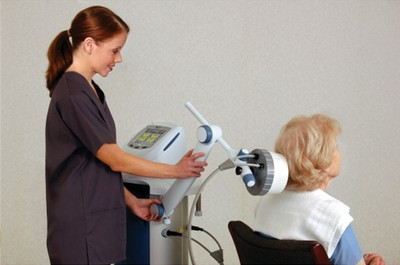 14th Mar 2017
14th Mar 2017
What is Short Wave Diathermy?
Ultrasound therapy machines are a popular modality that uses sound waves to reduce pain and swelling of soft-tissue injuries. This modality is used by practitioners like physical therapists and chiropractors to treat small, specific injury sites. Short wave diathermy is typically used as an alternative to ultrasound when a wider area of heat application is required.
What is Short-Wave Diathermy?

Diathermy is a therapeutic modality that is most commonly used for joint conditions such as rheumatoid arthritis and osteoarthritis. The term diathermy refers to the creation of heat using electrical pulses. In diathermy, a high-frequency electric current is delivered via shortwave, microwave, or ultrasound which is able to generate deep heat in body tissues. The heat can be used to improve circulation and/or to relieve pain. In addition, shortwave diathermy can be used in medicine for treating damaged tissues and relaxing muscles.
The electric pulse of Short-Wave Diathermy creates heat deep inside a targeted tissue, reaching areas as deep as two inches from the skin’s surface. While the diathermy machine doesn’t apply heat directly to the body, the current created by the machine allows the body to generate heat within the targeted area itself.
It is when the heat of the area increases, that blood flow is improved along with improvements to flexibility in stiff joints and connective tissue making it a good choice to use for patients with arthritis.
The main benefits for decreased pain and inflammation is it allows patients to gently increase their range of motion allowing them to move with more ease and participate in rehabilitation with more comfort.
Diathermy isn’t just used in rehabilitation. Diathermy can be used in surgical procedures where when the electrode can be applied to a blood vessel. The heat generated by diathermy in the vessel will cause the blood to coagulate allowing the vessel to be cauterize(seal).
Diathermy can also be used to remove abnormal growths, such as tumors, especially in procedures where traditional techniques are impractical. For example, surgical diathermy can be used to address issues in the prostate, bladder, cervix, brain, ovaries, bowels, eyes, and tonsils.
How Does Short-Wave Diathermy Work?
Short wave diathermy is a distinguished form of diathermy (different than ultrasound and microwave) which involves sending high-frequency waves throughout the patient’s body and into the affected tissues. The energy waves are sent from condenser plates located on either side of the tissue being treated. Typical short wave diathermy machines operate at a frequency of 27.33 MHz and have wave lengths of 11 meters.

Similar to other methods for applying energy to the body, short wave diathermy can be applied in two distinct modes: continuous or pulsed. When continuous mode is used, the tissue being targeted becomes heated as the waves constantly convey energy to them. Pulsed mode is used when less heat is desired for the affected tissue. When short wave diathermy is applied in pulse mode, the mechanical effects of the treatment are applied independent of the thermally affecting (heating) the tissue. One of the most promising applications of pulsed mode is it is able to facilitate increased flexibility and joint mobilization for restoration of joint range of motion. Short-wave diathermy includes non-thermal benefits as well including:
- Acceleration of cell growth
- Enabling damaged cells to return to normal function
- Increase wound healing
Short-wave Diathermy is also effective when used with other rehabilitative modalities. In a study published in the American Journal of Physical Medicine and Rehabilitation found that short-wave diathermy used with hot packs and isokinetic exercises were more effective in reducing pain and increasing function in participants with knee osteoarthritis.
Another study, Evaluation of the effects of shortwave diathermy in patients with chronic low back pain, found that short-wave diathermy significantly decreased pain, improved circulation and increased flexibility in patients with low-back pain.
Short-wave Diathermy is contraindicated for use over metal implants that have circular wire components or elements that form loops or circles, because it may result in excessive heating of the metal causing discomfort or possible injury.
What Conditions Can Short-Wave Diathermy Treat?
Short-wave Diathermy can be effective in providing some relief and treatment of symptoms related to:
- arthritis
- back pain
- fibromyalgia
- muscle spasms
- myositis
- neuralgia
- sprains and strains
- tenosynovitis
- tendonitis
- bone injuries
- bursitis
The following video, published by Leeds Metropolitan University, explains more about how short wave diathermy works and shows a patient receiving a treatment.
While diathermy isn’t as popular as ultrasound in rehabilitation, shortwave diathermy has some benefits that should increase its consideration and use in physical therapy and rehabilitation. Used alone as a pain management modality or used in conjunction with other modalities in order to increase function, diathermy is an extremely effective tool in returning patients to pain-free function. From managing pain to facilitating wound healing, diathermy is able to address diverse problems that come up in rehabilitation and should be a tool to consider adding to treatment regimens.





